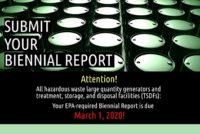Regulations the EPA has issued under the Resource Conservation and Recovery Act (RCRA) make important distinctions between the compliance obligations of large quantity generators (LQGs) and small quantity generators (SQGs) of hazardous waste.
Waste management can be a tricky business for hazardous waste generators and transporters and owners or operators of hazardous waste treatment, storage, and disposal facilities (TSDFs).
If you own or operate a facility that generates more than 100 kilograms of hazardous waste per month, you are subject to a suite of requirements under Subpart C of the federal Resource Conservation and Recovery Act (RCRA).
As hazardous waste large quantity generators (LQGs) and hazardous waste treatment, storage, and disposal facilities (TSDFs) know all too well, the Resource Conservation and Recovery Act (RCRA) requires them to report every two years on the quantities, types, and management methods of hazardous wastes generated on-site and hazardous wastes received from off-site sources. Referred to […]
In February 2019, the EPA issued a final rule establishing a new set of regulations for the management of hazardous waste pharmaceuticals generated by healthcare facilities. There were several rationales behind the rule. For example, in contrast to staff at industrial facilities, healthcare personnel (e.g., doctors and nurses) are rarely trained to make hazardous waste […]
In December 2019, the U.S. Department of Energy (DOE) took two actions that would appear to set the stage for the delivery of waste elemental mercury for long-term storage and management.
Does your facility need to file a Hazardous Waste Biennial Report? This infographic helps you decide and provides useful tips for preparing and submitting a Biennial Report.
In Montana v. United States (1981), the U.S. Supreme Court found that Indian tribes do not have civil or criminal jurisdiction over nontribal members within a reservation. This opinion has proven to be one of the clearest indications that Indian tribes possess no authority over lands they do not own (called non-Indian fee lands), even […]
An understanding of the Resource Conservation and Recovery Act (RCRA) term speculative accumulation is essential for managers overseeing compliance with regulations governing the generation of both hazardous waste and hazardous secondary materials (HSMs).
In 2013, the EPA promulgated a final rule that removed solvent-contaminated wipes that are either cleaned and reused or disposed of from regulation under the Resource Conservation and Recovery Act (RCRA). The exclusions come with conditions, meaning the generators of these wipes must conduct certain actions to qualify. One such condition described here is that […]










